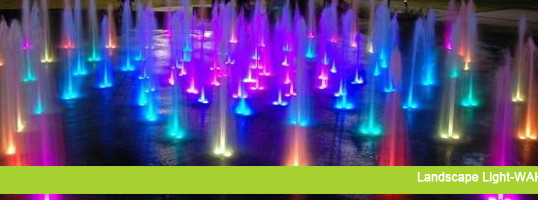
4 Key Points in Outdoor Lighting
Outdoor LED lighting lamps and lanterns design should comply with the latest China promulgated outdoor lighting lamps and lanterns technical specifications, as well as the city road lighting design standard.
1,working environment
Because of the working environment of LED outdoor lighting lamps and lanterns is bad, the wind, the rain and sunshine, the sunshine of ultraviolet radiation, the temperature difference changes in the air, dust, chemical gas conditions influence, lamps and lanterns year after year ageing treatment by nature. When designing, should fully consider the impact of these factors.
2, the selection of LED lamps and lanterns materials and cooling mode
Shell and radiator design for an organic whole, used to solve the heating problems LED, this way is better, generally choose aluminum or aluminum alloy, copper or copper alloys, and other alloy with good heat conduction. There are cooling air convection heat, wind cooling heat and heat pipe cooling. (jet cooling heat dissipation is similar to a heat pipe cooling, but more complicated structure)
Choose what kind of cooling mode has a direct influence on the cost of the lamps and lanterns, should be considered comprehensively, and design products choose the best scheme.
The design and the material selection of the chimney is important, now we use transparent organic glass, PC material, etc., traditional chimney is transparent glass products, how to choose the materials of the chimney has something with the design of product class position relevant, generally speaking, the best choice for chimney of outdoor lamps and lanterns is traditional glass products, it is the best choice making the long life and high-grade lamps and lanterns. The transparent plastic, organic glass, etc materials do chimney, it’s better to do the chimney of indoor lamps and lanterns, if used for outdoor, life is limited, because the outdoor sunlight, ultraviolet ray, sand and dust, chemical gases, day and night temperature difference change and other factors make lampshade aging life cut short, the second is the pollution is not easy to settle accounts clean, make lampshade transparency reduced affect light output.
3, LED chips encapsulation
The current domestic production of LED lamps and lanterns (mainly street lamp) are mostly use 1 w LED more series and parallel for assembly, this kind of method thermal resistance advanced packaging technology products is high, not easy to create high quality lamps and lanterns. Or is to use 30 W, 50 W even greater module for assembly, in order to achieve the required power, these LED encapsulation materials useful epoxy resin encapsulation, useful silica gel encapsulated. The difference is: epoxy resin encapsulation heat resistance is poorer. Time is long aging. Silica gel encapsulation is heat resistance is satisfactory, when using, should pay attention to choose.
The author’s view is: the more chips and radiator whole package is better, or use the aluminum plate more chip package again through the phase change material or heat silicone grease and radiator connected, make product thermal resistance than using LED device assembly product thermal resistance is less one or two word thermal resistance, and will be more suitable for heat dissipation. The LED module lamps and lanterns, module base plate is commonly copper base plate, it to the radiator of the connection to use good phase change material, or good heat dissipation silicone grease, guarantee the copper base plate of heat can promptly to the radiator up, such as processing is not easy to make heat accumulation cause module chip is too hot, influence the normal work of the LED chip. The author thinks that: chip packages suitable for manufacturing overall lighting lamps and lanterns. Module encapsulation limited space for the occasion of manufacturing compact led lamps and lanterns (such as car main lighting head lamp, etc.).
4, the design of the radiator
The radiator is one of the crucial parts of led lamps and lanterns, its shape, volume, heat dissipation surface area are designed to address the benefits, radiator is too small, led lamp working temperature is too high, influence the luminous efficiency and life, radiator is too large, the consumable material increase product cost and weight, make the product competition force down. Design the suitable led lamp radiator is very important. Radiator design has the following several parts:
1. Clear needing power for LED lamp cooling.
2. Some parameters when designing radiator: metal heat, the thermal conductivity of metal, chip thermal resistance, thermal resistance, the surrounding environment air thermal resistance, etc.
3. Determine the type of the heat dissipation, (natural convection, wind cooling, heat pipe cooling, and other cooling mode. From the cost comparison: natural convection cost minimum, wind cooling medium, heat pipe cooling cost is higher, jet refrigeration highest cost.
4. Define LED lamps and lanterns licensing the highest working temperature (environment temperature and lamps and lanterns licensing temperature rise)
5. Calculating the volume of the radiator, radiator area. And make sure the shape of the radiator.
6. The radiator and LED lighting sets synthetic complete lamps and lanterns, and energizing work more than eight hours at room temperature, 39 ℃ – and ℃ environment check the temperature of the lamps and lanterns, look to whether meet the cooling requirement, in order to check calculation is correct, such as do not satisfy the conditions of use, should recount and adjusting parameters.
7. The radiator and lamp shade seal to do waterproof, dust proof, chimney and the radiator to pad anti-aging rubber pad or silicone rubber pad, with stainless steel bolts and do seal waterproof, dust proof.
ShareAUG
2013
